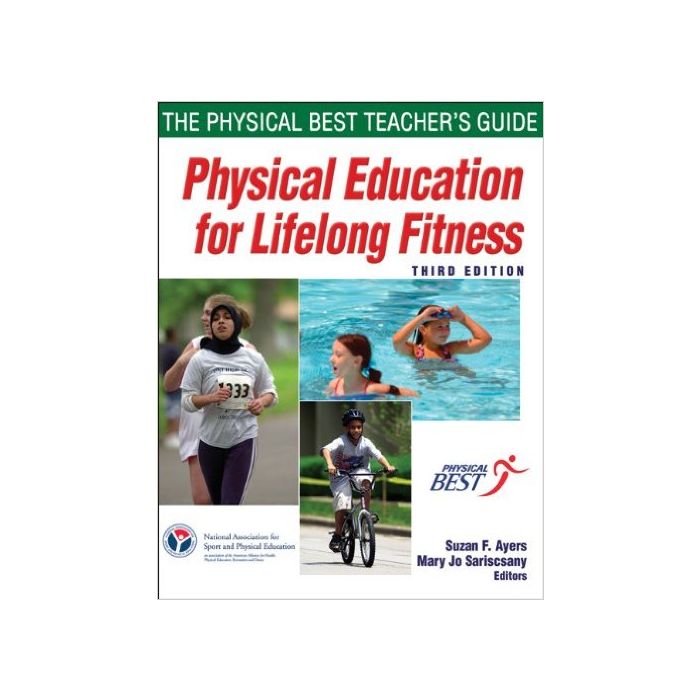Physical Education for Lifelong Fitness
CLOSEOUT ITEM!! ALL SALES FINAL!! NO EXCHANGES OR RETURNS ON THIS ITEM!!
Typically ships in 1 business day.
On Sale
$19.95
Regular Price
$39.00
SKU
B-PELF-9780736081160
Research shows direct links between regular physical activity, good health, and improved cognitive performance. Your students will receive those benefits when you incorporate the latest edition of this best-selling text into your physical education curriculum.
Physical Education for Lifelong Fitness: The Physical Best Teacher’s Guide is a practical, field-tested tool that provides teachers with strategies to emphasize health-related fitness while maintaining all the components of their existing programs. It also guides teachers in developing effective new fitness education programs.
This new edition is based on up-to-date research, current NASPE standards, and the new 2010 National Physical Activity Guidelines. It includes
Physical Education for Lifelong Fitness guides you in teaching fitness concepts through enjoyable activities and shows you how to use fitness testing as an educational and motivational tool. It provides an in-depth look at physical activity behavior, motivation, and training principles; it also presents aerobic fitness, muscular strength and endurance, flexibility, and body composition as they relate to your teaching. It also examines exercise protocols and outlines strategies for curriculum development that serves a variety of needs.
The text can stand alone or be used with the Physical Best Activity Guides for the elementary, middle school, and high school levels. Each of the activity guides comes with a CD that supplies worksheets, charts, and many other educational tools.
Physical Education for Lifelong Fitness is the text for NASPE Physical Best specialist and instructor certification workshops. Physical Best is also designed to complement Fitness for Liferesources (health-related fitness knowledge and activities for students K-12) and the Fitnessgram®/Activitygram® fitness and physical activity assessment.
Use Physical Education for Lifelong Fitness to update your curriculum with cutting-edge information and to infuse new life into your physical education program—which will have a healthy impact on the lives of your students, both now and far into their future.
Physical Education for Lifelong Fitness: The Physical Best Teacher’s Guide is a practical, field-tested tool that provides teachers with strategies to emphasize health-related fitness while maintaining all the components of their existing programs. It also guides teachers in developing effective new fitness education programs.
This new edition is based on up-to-date research, current NASPE standards, and the new 2010 National Physical Activity Guidelines. It includes
- updated health-related fitness concepts and expanded discussions on teaching principles and training concepts;
- enhanced information on assessment, nutrition, inclusion, and goal setting;
- examples for applying the material in real-world physical education settings; and
- ready-to-use instructor resources, including a presentation package and a test package.
Physical Education for Lifelong Fitness guides you in teaching fitness concepts through enjoyable activities and shows you how to use fitness testing as an educational and motivational tool. It provides an in-depth look at physical activity behavior, motivation, and training principles; it also presents aerobic fitness, muscular strength and endurance, flexibility, and body composition as they relate to your teaching. It also examines exercise protocols and outlines strategies for curriculum development that serves a variety of needs.
The text can stand alone or be used with the Physical Best Activity Guides for the elementary, middle school, and high school levels. Each of the activity guides comes with a CD that supplies worksheets, charts, and many other educational tools.
Physical Education for Lifelong Fitness is the text for NASPE Physical Best specialist and instructor certification workshops. Physical Best is also designed to complement Fitness for Liferesources (health-related fitness knowledge and activities for students K-12) and the Fitnessgram®/Activitygram® fitness and physical activity assessment.
Use Physical Education for Lifelong Fitness to update your curriculum with cutting-edge information and to infuse new life into your physical education program—which will have a healthy impact on the lives of your students, both now and far into their future.
Contents
Preface
Acknowledgments
Part I: Foundations of Health-Related Fitness and Physical Activity
Chapter 1. Introduction to Physical Best
What Is Physical Best?
What Makes Physical Best Unique?
Physical Best Companion Resources
Related Resources
Physical Best Certification
Summary
Chapter 2. Physical Activity Behavior and Motivation
Does Physical Activity Decline With Age?
Internal Factors Influencing Physical Activity Behavior
External Factors Influencing Physical Activity Behavior
Why Physical Activity Decreases With Age
Motivating Students to Be Active for Life
Creating Physical Education Programs That Motivate
Building a Fitness Program Using Student Goals
Summary
Chapter 3. Basic Training Principles
Understanding the Basic Training Principles
Applying the Basic Training Principles
Components of a Physical Activity Session
Social Support and Safety Guidelines
Summary
Chapter 4. Nutrition
Foundations of a Healthy Diet
Categories of Nutrition
Dietary Tools
Consequences of an Unhealthy Diet
Summary
Part II: Components of Health-Related Fitness
Chapter 5. Aerobic Fitness
Importance of Aerobic Fitness
Defining and Measuring Aerobic Fitness
Teaching Guidelines for Aerobic Fitness
Determining How Much Physical Activity Is Needed
Aerobic Fitness Training Principles
Monitoring Intensity
Cross-Discipline Ideas
Training Methods for Aerobic Fitness
Addressing Motor Skills Through Aerobic Fitness Activities
Safety Guidelines for Aerobic Fitness Activities
Summary
Chapter 6. Muscular Strength and Endurance
Definitions of Muscular Strength and Endurance Concepts
Benefits of Resistance Training
Resistance-Training Cautions
Teaching Guidelines for Muscular Strength and Endurance
Principles of Training
Training Methods for Muscular Strength and Endurance
Addressing Motor Skills Through Muscular Strength and Endurance Activities
Safety Guidelines for Muscular Strength and Endurance Activities
Summary
Chapter 7. Flexibility
Definitions of Flexibility Concepts
Types of Stretching
Benefits of Flexibility
Factors Affecting Flexibility
Teaching Guidelines for Flexibility
Principles of Training
Addressing Motor Skills Through Flexibility Activities
Safety Guidelines for Flexibility Activities
Summary
Chapter 8. Body Composition
Teaching Guidelines for Body Composition
Relating Body Composition to Other Health-Related Fitness Components
Methods of Measuring Body Composition
Helping the Overfat or Underfat Student
Summary
Part III: Curriculum and Teaching Methods
Chapter 9. Integrating Health-Related Physical Fitness Education Into the Curriculum
Curriculum Development
Recommended Core Content for a Health-Related Fitness Education
Physical Education Curriculum Analysis Tool (PECAT)
Program Design
National Standards
Developing Curriculum to Promote Lifetime Fitness
Fitness for Life
Determining Unit or Grade-Level Outcomes
Summary
Chapter 10. Teaching Styles and Strategies
Preparing the Environment
Teaching Styles
Enhancing Health-Related Fitness in the Classroom Setting
The Homework Concept
Extending Physical Activity Time
Technology
Summary
Chapter 11. Including Everyone
Relevant Laws
Benefits of Inclusion
Methods of Inclusion
Major Areas in Which to Ensure Inclusion
Summary
Part IV: Foundations of Assessment in Health-Related Fitness and Physical Activity
Chapter 12. Principles of Assessment
Assessment
Applying Assessment Tools
Grading and Reporting Student Progress
Using Assessments for Program Planning
Summary
Chapter 13. Assessing Health-Related Fitness and Physical Activity
Guidelines for Appropriate Health-Related Fitness Assessment
Fitnessgram
Tailoring Health-Related Fitness Assessment
Using Health-Related Fitness Results Appropriately
Guidelines for Appropriate Physical Activity Assessment
Strategies for Assessing Physical Activity
Using Physical Activity Assessment Results
Summary
Chapter 14. Assessing the Cognitive and Affective Domains
Cognitive and Affective Domains
Health-Related Fitness Knowledge: The Cognitive Domain
The Affective Domain
Tools for Assessing the Cognitive and Affective Domains
Grading in the Cognitive and Affective Domains
Summary
Appendix A: Worksheets and Reproducibles
Appendix B: Nutrient Content Claims
Appendix C: Exercises for Prepuberty
Appendix D: Alternatives for Questionable Exercises
Appendix E: Body Mass and Body Composition Measures
Appendix F: Student Asthma Action Card
Glossary
References
Index
About Physical Best
Acknowledgments
Part I: Foundations of Health-Related Fitness and Physical Activity
Chapter 1. Introduction to Physical Best
What Is Physical Best?
What Makes Physical Best Unique?
Physical Best Companion Resources
Related Resources
Physical Best Certification
Summary
Chapter 2. Physical Activity Behavior and Motivation
Does Physical Activity Decline With Age?
Internal Factors Influencing Physical Activity Behavior
External Factors Influencing Physical Activity Behavior
Why Physical Activity Decreases With Age
Motivating Students to Be Active for Life
Creating Physical Education Programs That Motivate
Building a Fitness Program Using Student Goals
Summary
Chapter 3. Basic Training Principles
Understanding the Basic Training Principles
Applying the Basic Training Principles
Components of a Physical Activity Session
Social Support and Safety Guidelines
Summary
Chapter 4. Nutrition
Foundations of a Healthy Diet
Categories of Nutrition
Dietary Tools
Consequences of an Unhealthy Diet
Summary
Part II: Components of Health-Related Fitness
Chapter 5. Aerobic Fitness
Importance of Aerobic Fitness
Defining and Measuring Aerobic Fitness
Teaching Guidelines for Aerobic Fitness
Determining How Much Physical Activity Is Needed
Aerobic Fitness Training Principles
Monitoring Intensity
Cross-Discipline Ideas
Training Methods for Aerobic Fitness
Addressing Motor Skills Through Aerobic Fitness Activities
Safety Guidelines for Aerobic Fitness Activities
Summary
Chapter 6. Muscular Strength and Endurance
Definitions of Muscular Strength and Endurance Concepts
Benefits of Resistance Training
Resistance-Training Cautions
Teaching Guidelines for Muscular Strength and Endurance
Principles of Training
Training Methods for Muscular Strength and Endurance
Addressing Motor Skills Through Muscular Strength and Endurance Activities
Safety Guidelines for Muscular Strength and Endurance Activities
Summary
Chapter 7. Flexibility
Definitions of Flexibility Concepts
Types of Stretching
Benefits of Flexibility
Factors Affecting Flexibility
Teaching Guidelines for Flexibility
Principles of Training
Addressing Motor Skills Through Flexibility Activities
Safety Guidelines for Flexibility Activities
Summary
Chapter 8. Body Composition
Teaching Guidelines for Body Composition
Relating Body Composition to Other Health-Related Fitness Components
Methods of Measuring Body Composition
Helping the Overfat or Underfat Student
Summary
Part III: Curriculum and Teaching Methods
Chapter 9. Integrating Health-Related Physical Fitness Education Into the Curriculum
Curriculum Development
Recommended Core Content for a Health-Related Fitness Education
Physical Education Curriculum Analysis Tool (PECAT)
Program Design
National Standards
Developing Curriculum to Promote Lifetime Fitness
Fitness for Life
Determining Unit or Grade-Level Outcomes
Summary
Chapter 10. Teaching Styles and Strategies
Preparing the Environment
Teaching Styles
Enhancing Health-Related Fitness in the Classroom Setting
The Homework Concept
Extending Physical Activity Time
Technology
Summary
Chapter 11. Including Everyone
Relevant Laws
Benefits of Inclusion
Methods of Inclusion
Major Areas in Which to Ensure Inclusion
Summary
Part IV: Foundations of Assessment in Health-Related Fitness and Physical Activity
Chapter 12. Principles of Assessment
Assessment
Applying Assessment Tools
Grading and Reporting Student Progress
Using Assessments for Program Planning
Summary
Chapter 13. Assessing Health-Related Fitness and Physical Activity
Guidelines for Appropriate Health-Related Fitness Assessment
Fitnessgram
Tailoring Health-Related Fitness Assessment
Using Health-Related Fitness Results Appropriately
Guidelines for Appropriate Physical Activity Assessment
Strategies for Assessing Physical Activity
Using Physical Activity Assessment Results
Summary
Chapter 14. Assessing the Cognitive and Affective Domains
Cognitive and Affective Domains
Health-Related Fitness Knowledge: The Cognitive Domain
The Affective Domain
Tools for Assessing the Cognitive and Affective Domains
Grading in the Cognitive and Affective Domains
Summary
Appendix A: Worksheets and Reproducibles
Appendix B: Nutrient Content Claims
Appendix C: Exercises for Prepuberty
Appendix D: Alternatives for Questionable Exercises
Appendix E: Body Mass and Body Composition Measures
Appendix F: Student Asthma Action Card
Glossary
References
Index
About Physical Best
Write Your Own Review










